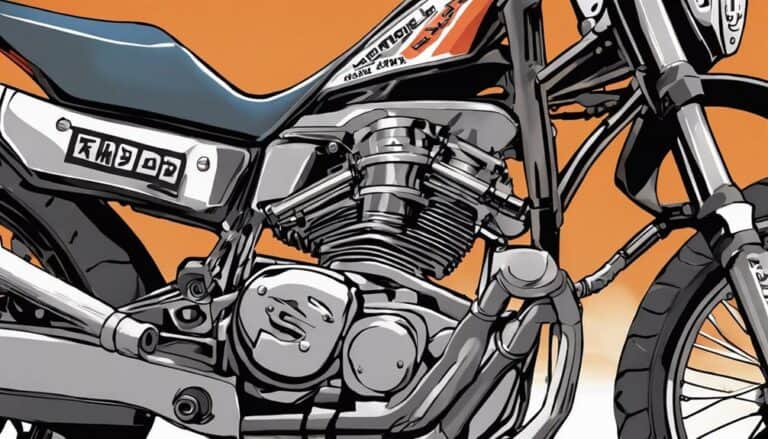When deciding which valves to replace on your dirt bike, the choice can be critical to your bike's performance. Evaluating the condition of valve guides, seats, valves, and springs is paramount.
A slight oversight in valve maintenance could lead to significant repercussions on your engine's reliability and power output.
Stay tuned to learn the key factors in determining when and which valves to replace for best dirt bike performance.
Key Takeaways
- Exhaust valves often wear faster than intake valves due to higher temperatures and stresses.
- Regularly check valve clearances to ensure optimal engine performance and prevent damage.
- Consult OEM specifications or consider aftermarket valves for enhanced durability and longevity.
- Professional inspection can identify specific valves needing replacement, ensuring proper fit and performance.
Signs of Valve Wear
If you notice reduced engine performance or difficulty starting, these could be signs of valve wear on your dirt bike. Valve wear is a common issue that can lead to a loss of compression and engine misfires.
To identify valve wear, a visual inspection is important. During this inspection, check for worn valve faces, stems, or guides. Look for any signs of damage or irregularities that may indicate wear and potential problems with the valves. Additionally, measuring the valve clearance can provide insights into the extent of wear and whether replacement is necessary.
Excessive valve lash or unusual noises during operation are also indicators of potential valve wear issues. By staying vigilant and conducting regular visual inspections, you can catch valve wear early and take the necessary steps to maintain an optimal engine performance on your dirt bike.
Importance of Valve Maintenance
Valve maintenance plays a critical role in ensuring prime engine performance and longevity for your dirt bike. Proper care of your valves is essential for the overall health of your engine.
Here are five key reasons why valve maintenance is crucial:
- Essential Engine Performance: Regular valve maintenance ensures that your engine operates at its best, providing you with maximum power output and efficiency.
- Prevention of Engine Damage: Delaying valve maintenance can result in serious engine damage, leading to costly repairs or even the need for a full engine replacement.
- Increased Valve Longevity: By staying on top of valve maintenance, you can extend the lifespan of your valves, reducing the need for frequent replacements.
- Improved Combustion Efficiency: New valves require properly cut seats to seal correctly, promoting efficient combustion within the engine.
- Prevention of Further Issues: Checking for a bent connecting rod after valve failures is essential to prevent additional problems and maintain the overall health of your engine.
Common Valve Replacement Intervals
Maintaining best valve replacement intervals is key to ensuring the continued performance and longevity of your dirt bike's engine. When it comes to valve replacement intervals, factors like the bike's make, model, and usage play an essential role. Generally, dirt bike valves, including intake and exhaust valves, may need replacement every 40-60 hours of operation. However, racing or high-performance bikes might require more frequent valve replacements to maintain the best performance.
To assist you further, here's a table summarizing common valve replacement intervals for different dirt bikes:
| Make/Model | Valve Replacement Intervals | Additional Notes |
|---|---|---|
| Dirt Bike A | 40-50 hours | Regularly check valve clearances |
| Dirt Bike B | 50-60 hours | Consider replacing valve stem seals |
| Racing Bike C | 30-40 hours | High-performance engines may need more frequent replacements |
Valve Inspection Techniques
Inspecting the valves on your dirt bike involves thorough examination of various components to secure performance and longevity. When checking your valves, make sure to:
- Inspect valve faces for wear patterns and pitting to determine replacement need.
- Measure valve stem diameter to check for excessive wear or out-of-spec dimensions.
- Check valve stems for bending or damage that can affect performance.
- Evaluate valve spring tension and free length to guarantee proper valve operation.
- Look for signs of valve seat recession or damage that may necessitate valve replacement.
To conduct a comprehensive valve inspection, consider using a valve spring compressor to safely remove and install valve springs for closer evaluation. By paying attention to details like valve seat recession, valve stem diameter, and overall valve condition, you can proactively address any issues before they impact the performance of your dirt bike.
Regular valve inspections are key to maintaining the best engine function and preventing costly repairs down the line.
Choosing the Right Replacement Valves
When selecting replacement valves for your dirt bike, prioritize identifying wear, damage, or performance issues to guarantee peak engine function. Exhaust valves often wear faster than intake valves due to the higher temperatures they're subjected to. Consult OEM specifications or a service manual to determine the recommended valve replacement intervals for your specific bike model. Consider upgrading to aftermarket valves for enhanced durability and performance if you frequently ride in demanding conditions. Professional inspection can help pinpoint which valves need replacement based on wear patterns, ensuring a more accurate assessment.
When installing new valves, make sure that they're correctly used to apply. Pay attention to the orientation, as valves have specific top and bottom positions for proper functioning within the engine. Properly fitting the valves according to their design is important for best engine performance and longevity. By investing in high-quality replacement valves and following precise installation procedures, you can maintain your dirt bike's engine in top condition for many rides to come.
Conclusion
Just like a well-oiled machine, your dirt bike's valves need regular check-ups and maintenance to guarantee peak performance.
By keeping an eye out for signs of wear, understanding the significance of valve maintenance, and knowing when to replace them, you can keep your engine running smoothly like a finely tuned instrument.
Remember, taking care of your valves is like tuning a guitar – it's all about precision and harmony for a perfect ride.

